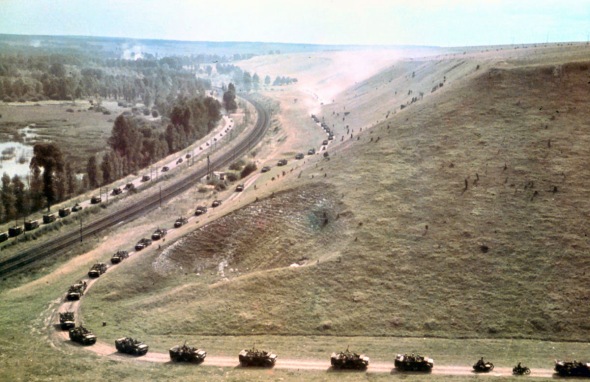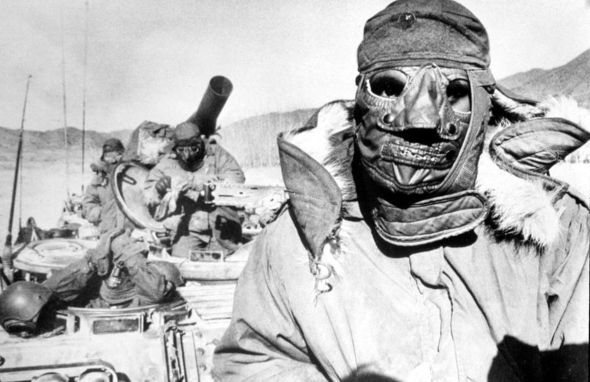American POW Paul Galanti unobtrusively gives the finger, to show his disdain for being used in a propaganda event filmed by an East German film crew in North Vietnam; ca. June 1967
After graduating from the U.S. Naval Academy in 1962, then-ENS Galanti reported to fighter jet training, learning to fly the A-4C Skyhawk. In November 1965, he deployed on the carrier USS Hancock to South East Asia. On his 98th combat mission in Vietnam, he was shot down and captured by the North Vietnamese. He spent almost seven years, from 17 June 1966 to 12 February 1973, interned in the infamous Vietnamese prison camp dubbed the “Hanoi Hilton.”
American prisoners of war have long been used as propaganda tools by the enemy — a weapon of war that has sometimes met with success, but has just as often left the enemy looking dim-witted and brutal.
When an East German camera crew arrived at his cell Navy Commander Paul Galanti was ordered to pose for photos.
A stencilled sign reading “Clean, Neat” had been painted on his wall and a makeshift bench, a luxury he did not normally have, was brought in.
“My interrogators wanted me to be interviewed by them and I said I’d be glad to speak with them because I speak German and I’d tell them all about the torture and bad treatment. They came back and said I was not to say anything to them,” Mr. Galanti said from his home in Richmond, Va., yesterday.
The captured aviator had no intention of being a propaganda tool for the enemy. As he sat with his hands resting between his knees he stared into the camera and had a flash of mischievous genius.
“I gave a catcher’s signal with both middle fingers extended and glared at the camera the whole time. I extended my middle finger on each hand to make certain that anybody who saw that picture didn’t think in any way, shape or form that I was doing it voluntarily.
“It was a message from me.”
(Source)
Another picture:
Life Magazine published this image in October, 1967, but airbrushed his middle fingers so as not to offend its readers:
German SS guards, exhausted from their forced labor clearing the bodies of the dead, are allowed a brief rest by British soldiers but are forced to take it by lying face down in one of the empty mass graves; ca. 1945
Taken during the liberation of the Bergen-Belsen concentration camp.
(Source)
There’s a famous quote from BBC journalist Richard Dimbleby, who was present at the liberation of this very camp.
Here over an acre of ground lay dead and dying people. You could not see which was which… The living lay with their heads against the corpses and around them moved the awful, ghostly procession of emaciated, aimless people, with nothing to do and with no hope of life, unable to move out of your way, unable to look at the terrible sights around them … Babies had been born here, tiny wizened things that could not live … A mother, driven mad, screamed at a British sentry to give her milk for her child, and thrust the tiny mite into his arms, then ran off, crying terribly. He opened the bundle and found the baby had been dead for days.
This day at Belsen was the most horrible of my life
Rudolph Hoss, the Commandant of Auschwitz, trying to avoid the noose, before being hanged on the grounds of Auschwitz; April 16, 1947
Höss introduced pesticide Zyklon B containing hydrogen cyanide to the killing process, thereby allowing soldiers at Auschwitz to murder 2,000 people every hour. He created the largest installation for the continuous annihilation of human beings ever known.
Edda Göring and her mother, Emmy Göring, receive a handwritten letter from Hermann Göring in his death cell at Nürnberg; September 26th, 1946
 Edda is the only daughter of Reichsmarschall Hermann Göring and Emmy Göring. Before married, Emmy (birth name Emma Johanna Henny Sonnemann) had been an actress. After marrying Göring in 10 April 1935, she became Germany’s first lady, since Hitler had no wife at the time. Emmy Göring was a genuinely gracious woman with a naive charm. Edda was born in 2 June 1938 and grew up in Berlin.
Edda is the only daughter of Reichsmarschall Hermann Göring and Emmy Göring. Before married, Emmy (birth name Emma Johanna Henny Sonnemann) had been an actress. After marrying Göring in 10 April 1935, she became Germany’s first lady, since Hitler had no wife at the time. Emmy Göring was a genuinely gracious woman with a naive charm. Edda was born in 2 June 1938 and grew up in Berlin.
This photograph of Edda and Emmy was taken in Nürnberg on 26 September 1946, during the war crimes trial. Nineteen days later, Hermann Göring took his own life a day before his scheduled execution. At that time Edda was eight years old. After the trial Edda and her mother spent four years in an Allied prison camp. Years later, her mother would say it was the hardest time of their lives. After being released they lived in Münich.
Emmy died in 1973. In 1991 Gerald Posner published some quotes from Edda in his book “Hitler’s Children”. Edda complained that after the war “the government was terrible. They didn’t even let me keep [my father’s] wartime medals. The Americans stole his special baton.” Edda was very much anti-America and probably blamed America in particular for her father’s death. She rejected the overwhelming evidence that her father was involved with the war crimes.
In Posner’s book Edda was quoted as saying, “My only memories of him are such loving ones, I cannot see him any other way. I actually expect that most everybody has a favorable opinion of my father, except maybe in America. He was a good father to me.”
Australian officers, blown into the air by an accidental explosion, fall in the river amid the splinters of their wrecked boat; ca. 1942
From LIFE (June 15th, 1942):
During night maneuvers in New South Wales a few weeks ago, Australian soldiers were landing at the edge of a dam when a charge of gelignite, employed to lend realism to their operation, unexpectedly exploded beneath their boat. Amid splinters and spray the Aussies were hurled into the night. As they fell, a photographer 20 feet away snapped his shutter and caught the remarkable picture opposite. The soldiers suffered only bruises and shock.
Wounded Knee Massacre – Mass grave for the dead Lakota after the conflict at Wounded Knee Creek; December 29th, 1890
The Wounded Knee Massacre occurred on December 29, 1890, near Wounded Knee Creek (Lakota: Čhaŋkpé Ópi Wakpála) on the Lakota Pine Ridge Indian Reservation in the U.S. state of South Dakota. On the day before, a detachment of the U.S. 7th Cavalry Regiment commanded by Major Samuel M. Whitsideintercepted Spotted Elk’s band of Miniconjou Lakota and 38 Hunkpapa Lakota near Porcupine Butte and escorted them five miles westward (8 km) to Wounded Knee Creek, where they made camp.
The remainder of the 7th Cavalry Regiment arrived, led by Colonel James W. Forsyth and surrounded the encampment supported by four Hotchkiss mountain guns.
On the morning of December 29, the troops went into the camp to disarm the Lakota. One version of events claims that during the process of disarming the Lakota, a deaf tribesman named Black Coyote was reluctant to give up his rifle, claiming he had paid a lot for it.A scuffle over Black Coyote’s rifle escalated and a shot was fired which resulted in the 7th Cavalry’s opening fire indiscriminately from all sides, killing men, women, and children, as well as some of their own fellow soldiers. The Lakota warriors who still had weapons began shooting back at the attacking soldiers, who quickly suppressed the Lakota fire. The surviving Lakota fled, but U.S. cavalrymen pursued and killed many who were unarmed.
By the time it was over, more than 200 men, women, and children of the Lakota had been killed and 51 were wounded (4 men, 47 women and children, some of whom died later); some estimates placed the number of dead at 300. Twenty-five soldiers also died, and 39 were wounded (6 of the wounded would later die).
(Source)
A group of Lithuanians attempt to stop a Soviet tank from crushing a fellow protester during the assault on the television station in Vilnius; January 13th, 1991
At least 13 people have been killed and more than 140 injured by the Soviet military in the capital of Lithuania as Moscow continues its crackdown on the Baltic republic and its drive for independence.
Troops broke through the defences set up by more than 1,000 protesters who had gathered to protect a Lithuanian radio and television centre at about 0200 local time.
Soldiers then smashed through the glass windows of the station and overwhelmed defenders armed with sticks.
The broadcast facility was one of several buildings seized by Soviet troops in Vilnius since they began cracking down on 11 January. Yesterday, tanks ploughed into unarmed demonstrators in Vilnius before soldiers opened fire on a crowd attempting to defend a government building.
The assault represents a major escalation in the Soviet Government’s use of force against the republic.
It is the bloodiest military attack on peaceful citizens since troops killed nine nationalist demonstrators in Georgia in 1989. (BBC)
Original caption: A group of Lithuanians attempt to stop a Soviet Red Army tank from crushing a fellow protester during the assault on the Lithuanian Radio and Television station early 13 January 1991 in Vilnius. Soviet troops opened fire on unarmed civilians in Vilnius, killing 13 people and injuring 100 others. Lithuania declared unilaterally its independence from Soviet Union 11 March 1990.
Adolf Hitler salutes a parade of his personal bodyguard regiment, the 1st SS Division Leibstandarte SS Adolf Hitler; January 30th,1937
Mechanized Column of the 7th Panzer-Division in France; ca. 1940

Shown here is a mechanized column of the 7th Panzer-Division, commanded by General major Erwin Rommel, on the move during the Blitzkrieg through France in the last days of May 1940. The photo was taken by General Rommel himself.
Skulls left lying on the battlefield after the Battle of the Wilderness – American Civil War; ca. 1864
Journalist Ernie Pyle after being killed during the battle of Okinawa; April 18, 1945
This photo apparently only surfaced in 2008. And technically this is apparently on Ie Shima, a small island near Okinawa.
Hungarian Jewish children and an elderly woman on the way to the death barracks of Auschwitz-Birkenau, ca. May 1944
“From the chimneys of the Vatican, white smoke rises,
a sign the Cardinals have chosen themselves a Pope.
From the crematoria of Auschwitz, black smoke rises,
a sign the conclave of Gods hasn’t yet chosen,
the Chosen People.
After Auschwitz, no theology:
the inmates of extermination bear on their forearms
the telephone numbers of God,
numbers that do not answer
and now are disconnected, one by one.
After Auschwitz, a new theology:
the Jews who died in the Shoah
have now come to be like their God,
who has no likeness of a body and has no body.
They have no likeness of a body and they have no body.”
– Smoke by Jacob Glatstein
























